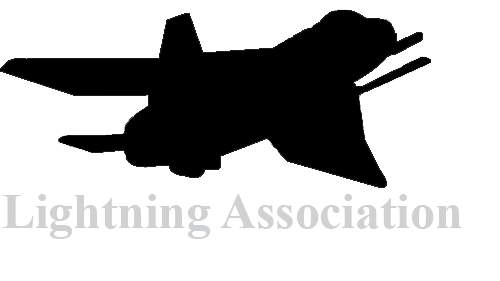Our history . . .
The Lightning Association was formed in the year following the aircraft’s retirement from RAF service in the spring of 1988 when a 'Lightning Rally' for all Lightning enthusiasts as well as aircrew and ground crew was organised at Binbrook on 2nd July 1989. It was a great success, and out of it the Lightning Association was born, with a Rally being held every summer. Although the Rally has not been held for some years, it is hoped that we may be able to resuscitate in the future what was always an excellent day and a chance for enthusiasts to come from all over the country and talk Lightning's.
The original aims of the Lightning Association were 1) To provide a platform for promoting the cause of Lightning preservation and informing members and the air-minded public of developments and 2) To foster communication and a spirit of goodwill between enthusiasts' groups with airframes. The Association had originally had no intention of itself getting involved with airframes. However, XR724 was the first of the five Lightning's allocated to British Aerospace at Warton as chase aircraft in the Tornado Foxhunter radar development trials to be retired and flown into storage at RAF Shawbury. It was put up for tender by MoD in 1991 and purchased by the Association.
The aircraft is owned by a group of shareholders who have put money into the project to buy shares. The XR724 Project has expanded to own a variety of equipment and spares, including three engines with documented air-life left on them. The Lightning Association holds several shares and holds the ultimate right of veto if there were an attempt to manage the project in an unacceptable fashion or to try to dispose of the airframe. The story of the purchase of XR724, its recovery for flight and its eventual final flight back to Binbrook is told in the XR724 section of this site.
Anyway, having set out to act as a focal point for the spread of information, it was decided that the best means of direct communication was via a magazine, and the Lightning Review was launched. From the first photocopied twelve-page issue, the Lightning Review grew to 32 pages in the second issue and by the third issue was being properly printed on glossy paper. It acquired a twelve-page technical supplement and helped the membership grow to 500 at its highest point. This is just some of the contents list from previous issues, many of the articles being accompanied by previously unseen photographs from members' collections.
However, everything is subject to change, and the Lightning Association was no exception. It became increasingly difficult to obtain enough material to maintain the high standards of production which members had come to expect from the magazine. Rather than let it wither slowly, the decision was taken in September 1995 to have a final 100-page bumper issue using all the available remaining material and photographs and to call it a day on a high note. However, under considerable pressure from the membership and with new articles and stories of Lightning's being submitted to the editor, Charles had his arm twisted and the Review was brought back to life, with the Phoenix edition coming out in July 1996. Nevertheless, print costs were rising and unpublished stories were drying up, and so the last print issue of the Lightning Review was Volume 7, No 3, which came out in January 2004.
Nevertheless, since then Charles has collected, and is still collecting, stories from anyone connected with Lightning's, from former RAF personnel to members of the public who witnessed an ejection. Following the reconstruction of this website in 2011 (and again in 2023), the old SOTM (Story of the Month) feature on the site will become Lightning Tales and will continue the already published list of Lightning stories with a mixture of new stories and archived articles from the Lightning Review and other publications.
Over the past several years the pace of not only the Association itself, but also the work on the aircraft we maintain has slow gathered pace. While the Association itself finally entered the social media domain in 2017, the Engineering Team has also been expanded to cover the ever-increasing workload required. All this coupled with a new-look website, now places both the Lightning Association itself and the aircraft we tender back firmly in the public domain and safeguards the commitments and ideas that we started out with many years ago.





